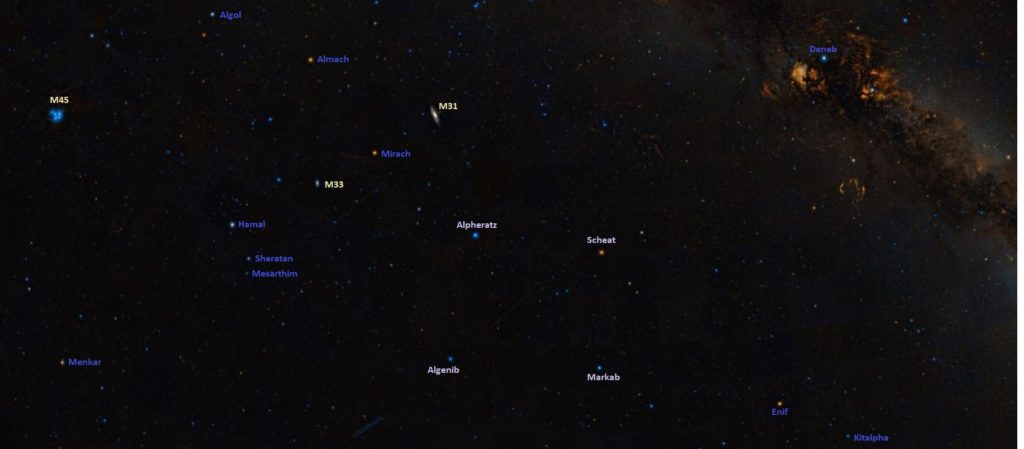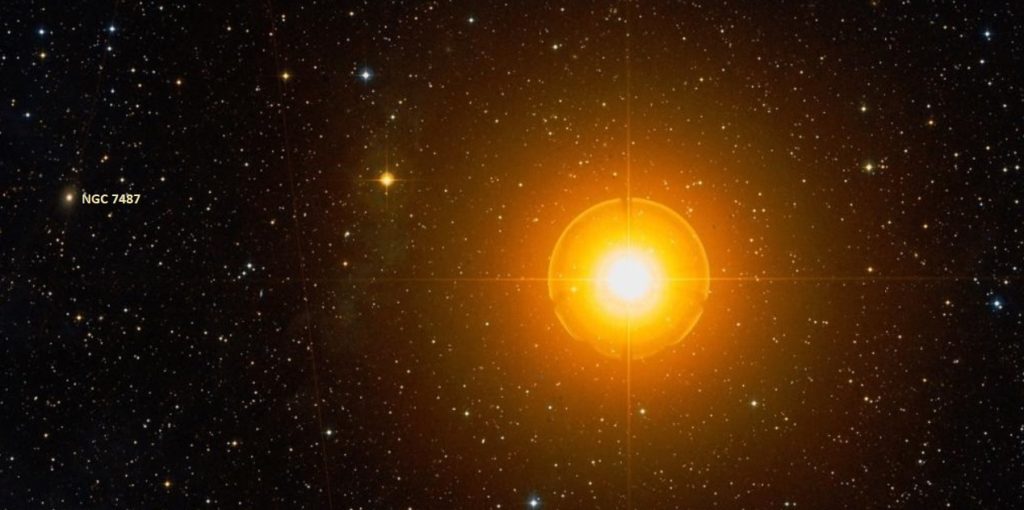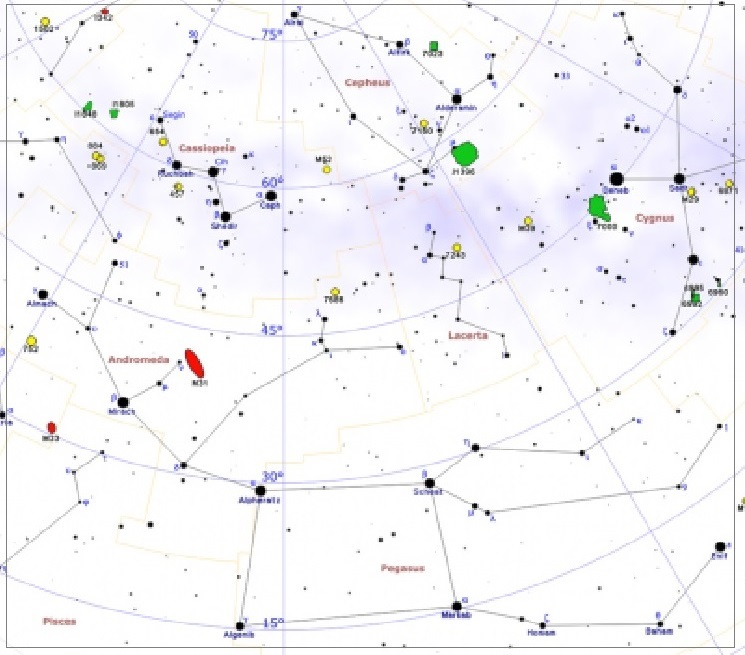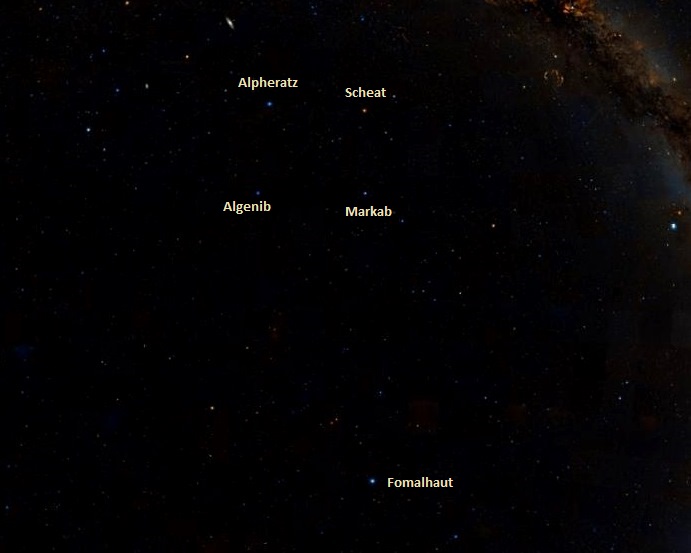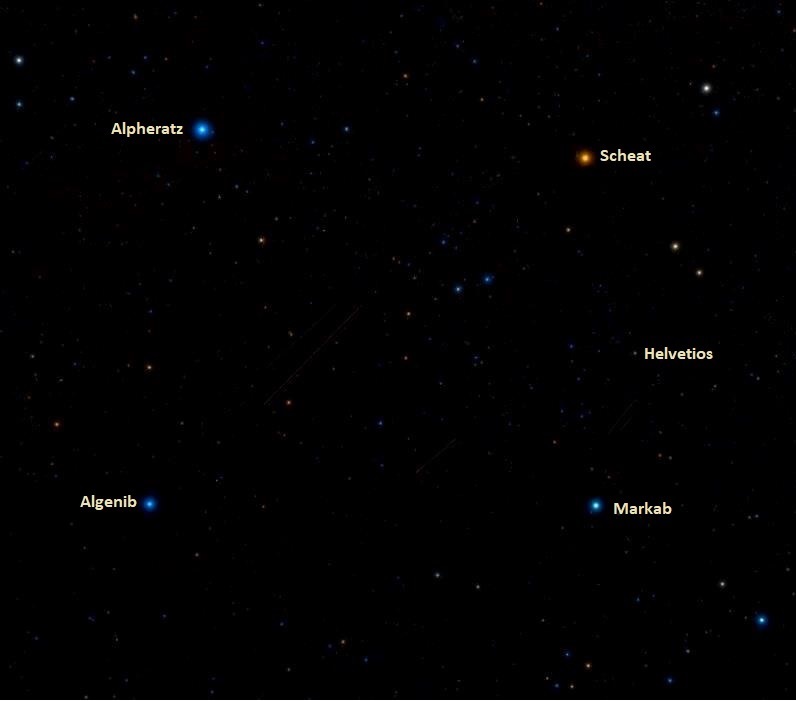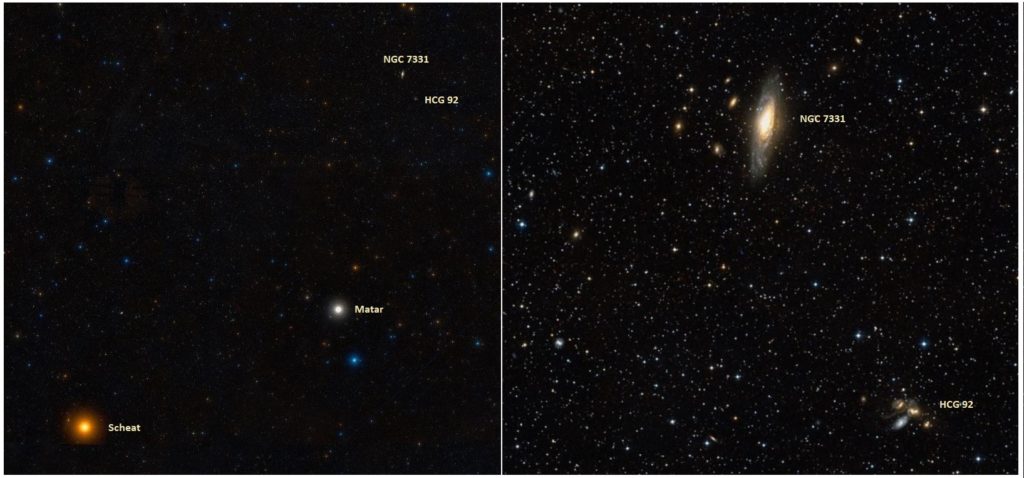Scheat, Beta Pegasi (β Peg) is a red giant star located in the constellation Pegasus. With an apparent magnitude of 2.42, it is the second brightest star in Pegasus, after the orange supergiant Enif. Scheat lies at a distance of 196 light years from Earth. It is one of the four bright stars that form the Great Square of Pegasus, an asterism that dominates the eastern half of the constellation.
Star type
Scheat has the stellar classification M2.5II–IIIe, indicating a giant (III) or bright giant (II) star appearing reddish in colour. The star has a mass of 2.1 solar masses and has expanded to a size of 95 solar radii. With an effective temperature of 3,689 K, it is 1,500 times more luminous than the Sun, but most of its energy output is in the invisible infrared. The star’s projected rotational velocity is 9.7 km/s.
Scheat is surrounded by an expanding envelope of gas and dust lost from the star. The dust shell has a radius of 16 astronomical units or 3,500 solar radii. The star is losing mass at a rate of up to 10-8 solar masses per year due to a strong stellar wind.
Scheat is classified as a semi-regular variable. Its brightness varies from magnitude 2.31 to 2.74 over a period of 43.3 days.
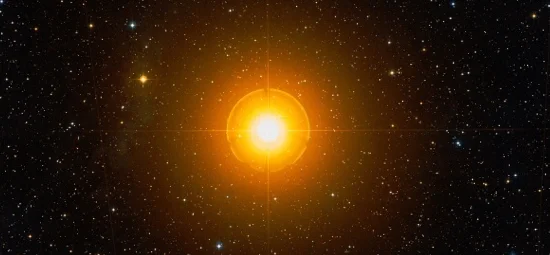
Scheat (Beta Pegasi), image: Wikisky
Facts
Scheat marks the northwest vertex of the Great Square of Pegasus, a prominent asterism that outlines the main body of Pegasus. The stars that mark the other three corners are Markab (Alpha Pegasi), Algenib (Gamma Pegasi), and Alpheratz (Alpha Andromedae). Scheat is the second brightest star in the Great Square, slightly outshining its Pegasus neighbours Markab (mag. 2.48) and Algenib (mag. 2.84), but not quite as bright as Alpheratz (mag. 2.06), the luminary of the neighbouring constellation Andromeda. With a size of 95 solar radii, Scheat is by far the largest of the four stars. The other three are under 5 solar radii in size.
Name
The name Scheat (pronunciation: /ˈʃiːæt/) comes from the Arabic Al Sā’id, meaning “the upper arm.” It was once also used for Delta Aquarii, now formally known as Skat. The name Skat was also (erroneously) used for Beta Pegasi in the late Middle Ages. It is derived from the Arabic al-sāq, meaning “shin.”
The name Scheat was approved by the International Astronomical Union’s (IAU) Working Group on Star Names (WGSN) on June 30, 2016.
In Arabic astronomy, Beta Pegasi was also known as Mankib al Faras, “the horse’s shoulder,” or as Menkib. The name Mankib al Faras was mentioned by the 15th century Timurid astronomer Ulugh Beg, who compiled the most extensive star catalogue between those of the 2nd CE century Greek astronomer Claudius Ptolemy and the 16th century Danish astronomer Tycho Brahe.
The 17th century astronomers Johann Bayer and Giovanni Battista Riccioli called the star Seat Alpheras and Scheat Alpheraz respectively. The names mean “the upper arm of the horse.”
The Chinese know Scheat as 室宿二 (Shì Xiù èr), the Second Star of Encampment. The Chinese Encampment asterism is one of the seven mansions of the Black Tortoise. It is formed by Markab and Scheat, the western stars of the Great Square of Pegasus.
Location
Scheat is easy to find because it marks the northwest vertex (the upper right corner) of the Great Square of Pegasus. Of the four stars that form the asterism, Scheat is the closest to the Northern Cross in Cygnus and to the constellation Lacerta, recognizable for its zig-zag shape. The galaxy NGC 7487 lies in the same field of view as the star.
The Great Square of Pegasus can be found using the bright stars of Cassiopeia that form the W asterism. A line drawn from Segin, Epsilon Cassiopeiae, through Ruchbah, Delta Cassiopeiae, points in the direction of the asterism.
Scheat and Markab, the star at the lower right corner of the Great Square, can be used to find Fomalhaut, the 18th brightest star in the sky and the luminary of the constellation Piscis Austrinus, the Southern Fish. Fomalhaut is bright, but not easy to identify because it lies in an area without any other particularly bright stars or asterisms. A line extended from Scheat through Markab points in the direction of the star.
Scheat and Markab can also be used to find 51 Pegasi, the first Sun-like star discovered to host an exoplanet, which lies in the area between the two brighter stars. Formally named Helvetios, 51 Pegasi has an apparent magnitude of 5.49 and lies 50.45 light years away.
Scheat and its fainter neghbour Matar (Eta Pegasi) make a good starting point for finding the NGC 7331 Group and Stephan’s Quintet. Also known as the Deer Lick Group, the NGC 7331 Group is a striking visual grouping of galaxies, the brightest of which is the spiral galaxy NGC 7331. The galaxies lie at different distances and are not physically associated.
Stephan’s Quintet (Hickson Compact Group 92), on the other hand, is a grouping of four interacting galaxies and a fifth galaxy that lies in the same line of sight. The interacting galaxies will eventually collide and merge into one large elliptical galaxy.
Constellation
Scheat is located in the constellation Pegasus. Named after the winged horse in Greek mythology, Pegasus is the seventh largest constellation in the sky, occupying an area of 1,121 square degrees. It is one of the Greek constellations, first listed by the astronomer Claudius Ptolemy in the 2nd century CE.
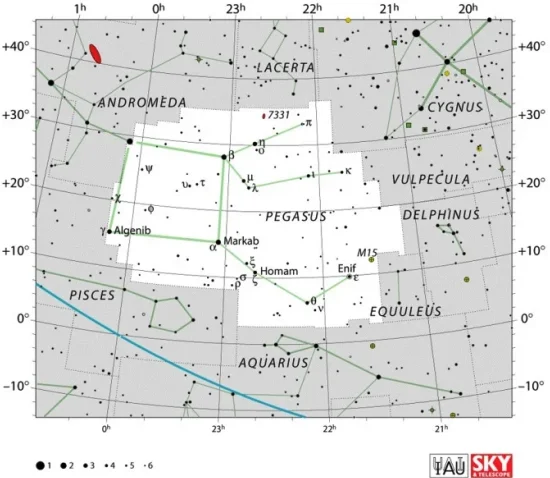
Pegasus constellation map by IAU and Sky&Telescope magazine
Pegasus contains a number of notable deep sky objects. These include the bright globular cluster Messier 15 (Great Pegasus Cluster), the compact galaxy group Hickson 92 (Stephan’s Quintet) and its brighter, larger neighbour, the unbarred spiral galaxy NGC 7331, the gravitationally lensed quasar known as Einstein’s Cross, and the spiral galaxies NGC 7814 (the Little Sombrero Galaxy), NGC 7742 (the Fried Egg Galaxy) and NGC 7479 (the Propeller Galaxy).
The best time of year to see the stars and deep sky objects of Pegasus is during the month of October, when the constellation rises high in the evening sky.
The 10 brightest stars in Pegasus are Enif (Epsilon Peg, mag. 2.399), Scheat (Beta Peg, mag. 2.42), Markab (Alpha Peg, mag. 2.48), Algenib (Gamma Peg, mag. 2.84), Matar (Eta Peg, mag. 2.95), Homam (Zeta Peg, mag. 3.414), Sadalbari (Mu Peg, mag. 3.514), Biham (Theta Peg, mag. 3.52), Iota Pegasi (mag. 3.77), and Lambda Pegasi (mag. 3.93).
Scheat – Beta Pegasi
| Spectral class | M2.5II–IIIe |
| Variable type | Semi-regular |
| U-B colour index | +1.96 |
| B-V colour index | +1.67 |
| Apparent magnitude | 2.42 (2.31 – 2.74) |
| Absolute magnitude | -1.41 |
| Distance | 196 ± 2 light years (60.1 ± 0.5 parsecs) |
| Parallax | 16.64 ± 0.15 mas |
| Radial velocity | +8.7 km/s |
| Proper motion | RA: +187.65 mas/yr |
| Dec.: +136.93 mas/yr | |
| Mass | 2.1 M☉ |
| Luminosity | 1,500 L☉ |
| Radius | 95 R☉ |
| Temperature | 3,689 K |
| Metallicity | -0.11 dex |
| Rotational velocity | 9.7 km/s |
| Surface gravity | 1.20 cgs |
| Constellation | Pegasus |
| Right ascension | 23h 03m 46.45746s |
| Declination | +28° 04′ 58.0336″ |
| Names and designations | Scheat, Beta Pegasi, β Peg, 53 Pegasi, HD 217906, HR 8775, HIP 113881, BD +27°4480, FK5 870, GC 32135, GCRV 14468, SAO 90981, PPM 115095, ADS 16483 A, CCDM J23038+2804A, IDS 22589+2732 A, WDS J23038+2805A, IRAS 23013+2748, 2MASS J23034644+2804580, LTT 16769, NLTT 55708, PLX 5583, TYC 2243-1831-1 |
